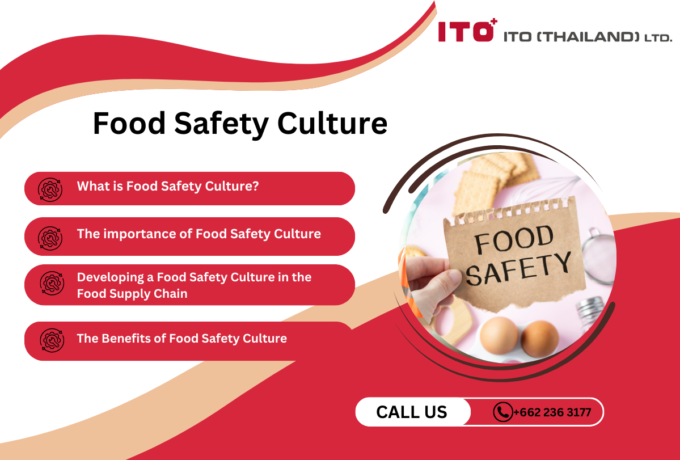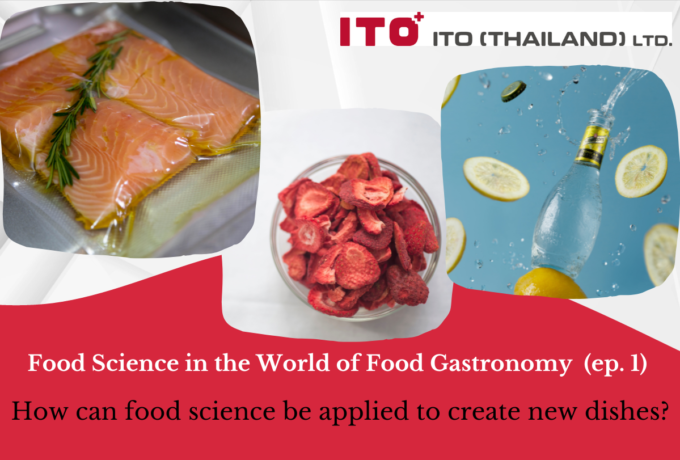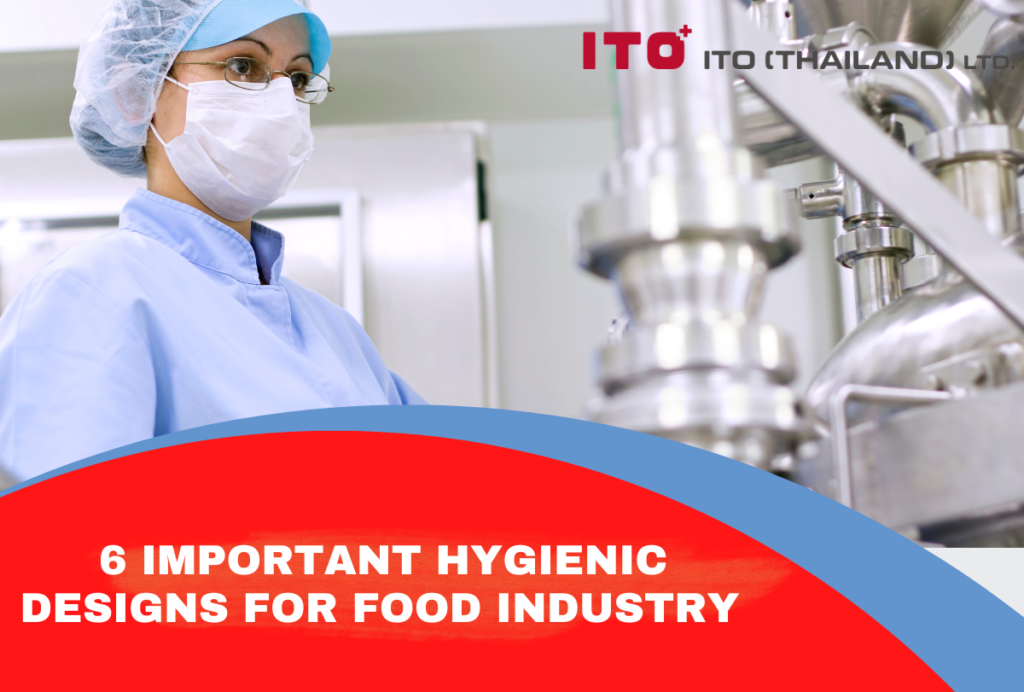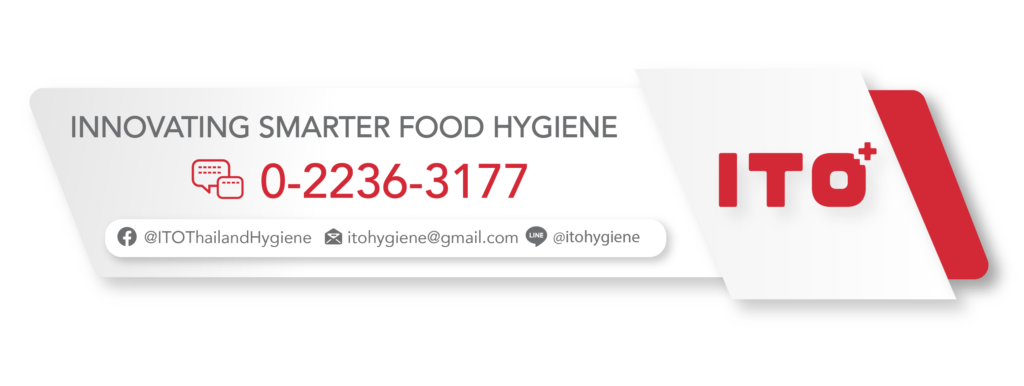ITO Thailand Hygiene Blog
6 important hygienic designs for food industry
To design the food industry to have good hygiene is very important both in terms of laws, standards, production license acquisition and responsibilities for consumers and society to live in a food safety and sustainability society. Today, Ito Thailand would like to present 6 important hygienic designs ranging from designing the food industrial plant to the development of the existing original system to become even better.
»Location planning
The location of the food production facility is very important. In general, the location is prioritized to be near the sources of raw materials or convenient for transportation. However, other issues to be carefully taken into consideration are to situate far away from various sources that cause contamination and danger such as animal stables, waste pits, chemical plants, smoke and dust production sites, etc., as well as, lowlands prone to flooding.
»Construction design
Food production facility must be properly designed as follows:
•Materials and equipment used in production section must be food safety, easy to clean, corrosion resistant, no nooks and crannies that harbor microorganisms or vectors, including left over water.
•Separation of high and low risk zones (Read more) including the proper allocation of the room into sections, air ventilation and wastewater flow from high-risk area to low-risk area including the operation of the production process must not be at risk of cross contamination.
•Procedures and locations for delivery of raw materials, products and transportation parking must be designed not to cause contamination.
•Surrounding environment must not be sources of accumulated contaminants, sewage and pests such as ratholes, large trees where birds may nest and light that may attract insects. It is suggested that lighting poles, bushes and trees should be at least 30 feet away from the production building (1).
•Entrances and exits including in and out monitoring policy must be designed to prevent outsiders and food terrorism.
•Temperature must be properly set and controlled to prevent microbial growth.
•Space must be sufficiently provided to promote employee hygiene such as restrooms, changing rooms, shoe changing areas and properly separated device storage.
•Cleaning and disinfection in the production area must be planned and documented.
•Attention must be paid to doorways, openings that may be contaminated or be the entrances and exits of air, temperature, pests (e.g., rats, birds, insects), dust, smoke, odors, etc. Technology may be adopted to assist reducing the risk of contamination from the environment in the entry and exit areas of production section.
»Focus on machine & equipment
Equipment, tools, machines contacting with food must be safe, not spread the chemicals or contaminants into food, resistant to production conditions, such as acid-resistant, heat-resistant, and designed to be cleanable, dis-infectable and have smooth surfaces, without nooks and crannies or accumulations of dirt and germs. Additionally, tools and equipment may be differently colored according to the risk areas; for example, for high-risk areas, for allergens, for cleaning the floor, etc., as well as, should have a color that is clearly different from the food in order to reduce the risk of food contamination. Presently, metal powders are added to equipment such as metal-detectable gloves in order to be able to detect product contamination with a metal detector.
»Ensure good process
Production process is crucial to food safety. Therefore, our food production process must be ensured to meet the good hygienic standards and produce the products that are safe for consumers.
•Raw materials and water must be clean without contaminants, chemicals and unwanted microorganisms. Therefore, it is required to plan starting from the selection, determination of specifications, inspection of raw materials and water to meet cleanliness standards including designing the storage of raw materials before use.
•The process from raw section to cooked section is set into a single process in order to prevent cross contamination.
•Steps of production process to reduce microbial count such as washing, acid adjustment, water activity control and heating must be planned to determine the critical factors and supervision to ensure that the production process is in accordance with the requirements including evidence to confirm the correctness of disinfection and be documented.
»Waste management
According to a survey of Ito Thailand in June 2022 on the cleanliness problems in food factories, the problems are found to be 36.7% about the waste and 33.5% about the wastewater pollution (surveyed from a sample group of 292 people). These are the biggest problems found in food factories causing the employees’ health risks at the production process and the risk of product contamination. Hence, planning is required to determine how to manage waste such as designation of a closed waste collection site which is away from production facility in order to prevent odors, microorganisms and pests, the drain which is designed to be wide and slope enough for the water to flow from the high-risk area to the low-risk area and wastewater treatment before releasing to the environment. In addition, there must be a systematic maintenance plan of waste management system.
»Personal hygiene care
Employees are another key factor in the production process and may become carriers of contaminants into the production process (Learn more) either hair, dust on clothes or dirt attached to shoes, etc. Therefore, it is necessary to design the facilities to promote hygiene such as hand wash basins, hair remover rollers, hair caps, robes, aprons and footwears to be sufficient, as well as, equipment to be cleaned regularly including setting up the rules to help controlling along with training to educate the knowledge to promote food safety culture awareness in the organization.
In this connection, Ito Thailand would like to present the equipment to help promoting the hygiene of employees in the production process such as dust and hair vacuum cleaners, urethane gel pads to trap dirt on the body and shoes, automatic shoe washing machines, air showers, AI-based handwash monitoring system including robotic and automation systems to reduce the risk of contamination from employees to enhance production efficiency and upgrade safety standards in food factories.
Contact us today for our advice on upgrading the cleanliness standards of your food factory with technology.
References
1.Ronald H. Schmidt & Daniel J. Erickson. 2005. Sanitary Design and Construction of Food Processing and Handling Facilities. IFAS Extension. University of Florida.
Related Post
-

Food Safety Culture
Food safety culture plays a crucial role in safeguarding the company's reputation, ensuring the well-being of its employees, and providing a safe experience for its customers.
-

New food source safety issues
What are safety issues worth knowing for trendy new food sources like plant-based and insect-based proteins?
-

British Retail Consortium (BRC) Standard
Food safety management systems play a vital role in ensuring the production and distribution of safe and high-quality food products to consumers. With the global food supply chain becoming increasingly complex, food businesses must implement effective systems prioritising safety, quality, and compliance with industry standards. A food safety management system encompasses a set of procedures, processes, and controls designed to identify, prevent, and manage potential hazards at every stage of the food production and supply process. This proactive approach not only safeguards consumers' health but also protects the reputation and credibility of food companies in an ever more competitive market.
-

Food Science in the World of Food Gastronomy (Part 1)
How can food science be applied to create new dishes?
-

FSSC 22000
Food manufacturers must ensure food safety standards and processes. FSSC 22000 is an official certification program for Food Safety Management Systems (FSMS) recognised by the Global Food Safety Initiative (GFSI). This certification scheme offers a set of guidelines and procedures to ensure uniformity, openness, and safety across your entire supply chain. It applies to all companies operating within the food and beverage industry, ranging from farmers to retailers. By fulfilling the necessary criteria and obtaining FSSC 22000 certification, it is demonstrated that the required standards for food quality and implementing effective processes to manage and mitigate risks associated with food fraud, foodborne illnesses, expensive recalls, and other external threats are met.
-

Food Safety Aspects of Artificial Sweeteners
Artificial sweeteners, also known as sugar substitutes, non-nutritive sweeteners, or high-intensity sweeteners, are artificially produced compounds utilised in place of sucrose (table sugar) to add sweetness to food and drinks. Due to their significantly higher sweetness than regular sugar, only a fraction of artificial sweeteners (200 to 20,000 times less) is required to achieve an equivalent level of sweetness. Since the caloric contribution of these sweeteners, when used in such small quantities, is insignificant, they are often referred to as non-nutritive (4).










